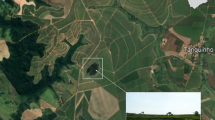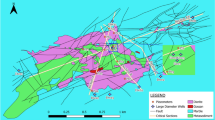Abstract
Geological transition zones (GTZ) have proved to be hydrogeologically problematic, owing to poorly defined basal and lateral contacts between the rocks. Several occurrences of abortive wells in GTZ overtime has necessitated the need to characterise groundwater potential zones (GPZ) in these zones. Attempts have been made to delineate the complex lithological contacts in GTZ using geophysical and geological methods. However, the characterisation of groundwater prospective zones in these complex lithological contacts, which are very significant to the sustainable management of groundwater in GTZ, have not received much attention. Therefore, this study focused on the characterisation of the groundwater prospects of aquifers in a typical GTZ in Bauchi-Alkaleri-Kirfi areas, Northeastern Nigeria. Geological mapping was employed for the lithological delineation of rocks while geoelectrical mapping using 94 vertical electrical sounding (VES) was adopted for characterisation of subsurface media (aquifers). Three thematic maps comprising of aquifer resistivity, thickness and lithology were integrated using overlay analysis in the GIS environment to generate a GPZ map. Geologically, the basement part of the GTZ is underlain by migmatite, gneiss, granite and charnockite while the sedimentary areas were underlain by the sandstone units of the Tertiary Kerri Kerri Formation. The VES data indicated a generally 3–5 geoelectric layer system within the sedimentary zones with aquifer thickness of 11–158 m in the sandstones. However, the Basement Complex areas revealed saprolite thicknesses of 2.4–83.8 m (migmatite/gneiss), 1.3–67.3 m (granite) and 1.2–44.6 m (charnockite), suggesting a better aquiferous medium in the migmatite/gneiss units. Consequently, integration of thematic maps revealed three GPZ namely: poor zones (charnockite and granite), moderate zones (migmatite/gneiss and granite), and good zones (dominantly sandstone). This study shows the efficacy of applying GIS to VES data in groundwater exploration for better management of groundwater resources.









Similar content being viewed by others
References
Abiola O, EnikanseluOladapo PAMI (2009) Groundwater potential and aquifer protective capacity of overburden units in Ado-Ekiti, southwestern Nigeria. Int J Phys Sci 4(3):120–132
Adelana SMA, MacDonald AM (2008) Groundwater research issues in Africa. In: Adelana SMA, MacDonald AM (eds) Applied research studies in Africa. CRC/Balkema, Amsterdam, pp 1–7
Adepelumi AA (2008) Delineation of saltwater intrusion into the freshwater aquifer of Lekki Peninsula, Lagos, Nigeria. Environ Geol 56:927–933
Akanbi OA (2018) Hydrogeological characterisation and prospect of basement Aquifers of Ibarapa region, southwestern Nigeria. Appl Water Sci 8(89):1–22. https://doi.org/10.1007/s13201-018-0731-9
Ariyo SO, Adeyemi GO (2016) Hydrogeophysical investigation for groundwater potential of Ishara/Ode-Remo geological transition zone, southwestern Nigeria. Arab J Geosci 9(14):631
Asfahani J (2007) Geoelectrical investigation for characterizing the hydrogeological conditions in semi-arid region in Khanasser valley. Syria J Arid Environ 68(1):31–52. https://doi.org/10.1016/j.jaridenv.2006.03.028
Attwa M, Basokur AT, Akca I (2014) Hydraulic conductivity estimation using direct current (DC) sounding data: a case study in East Nile Delta. Egypt Hydrogeol J 22:1163–1178
Babu HVR, Rao NK, Kumar VV (1991) Bedrock topography from magnetic anomalies. An aid for groundwater exploration in hard-rock terrains (short note). Geophysics 56(07):1051–1054. https://doi.org/10.1190/1.1443113
Benkhelil J (1989) The origin and evolution of the Cretaceous Benue Trough (Nigeria). J Af Earth Sci 8:251–282. https://doi.org/10.1016/S0899-5362(89)80028-4
Burke KC, Dewey JF (1972) Orogeny in Africa. In: Dessauvagie TFJ, Whiteman AJ (eds) Africa geology. University of Ibadan Press, Ibadan, pp 583–608
Calow RC, MacDonald AM, Nicol AL, Robins NS (2010) Groundwater security and drought in Africa: linking availability, accesses and demand. Groundwater 48:246–256. https://doi.org/10.1111/j.1745-6584.2009.00558.x
Carter JD, Barber WM, Tait EA (1963) The geology of parts of Adamawa, Bauchi and Bornu provinces of North Eastern Nigeria. Geol Surv Niger Bull 30:1–180
Dada SS (2006) Proterozoic evolution of Nigeria. In: Oshi O (ed) The basement complex of Nigeria and its mineral resources (A tribute to Prof. Rahaman, MAO). Akin Jinad & Co, Ibadan, pp 29–44
Dan-Hassan MA, Olorunfemi MO (1999) Hydrogeophysical investigation of a basement terrain in North Central part of Kaduna State Nigeria. J Min Geol 4(2):189–206
Dike EFC (1993) Stratigraphy and structure of the Kerri-Kerri Basin, NE Nigeria. J Min Geol 29(2):77–79
Elueze AA (1982) Rift system for Proterozoic schists belts in Nigeria. Tectonophy 209:167–169
Falconer JD (1911) The geology and geography of Northern Nigeria. Macmillan, London, pp 1–135
Fashae OA, Tijani MN, Talabi AO, Adedeji OI (2014) Delineation of groundwater potential zones in the crystalline basement terrain of SW-Nigeria: an integrated GIS and remote sensing approach. Appl Water Sci 4(1):19–38
Hazell JRT (1985) Development of groundwater resources for farming communities in Bauchi state, Nigeria. Int J Climatol 33:1924–1935
Hewaidy AA, El-Motaal EA, Sultan SA, RamdanEl khafif TMAA, Soliman SA (2015) Groundwater exploration using resistivity and magnetic data at the northwestern part of the Gulf of Suez, Egypt. Egypt J Pet 24(3):255–263. https://doi.org/10.1016/j.ejpe.2015.07.010
Ishola K, Ogunsanya S, Adiat K, Abdulrahaman A (2013) Assessing groundwater potential zones in basement complex terrain using resistivity depth soundings: a case of challenge and Oluyole in Ibadan, Southwestern. Niger J Sci 1(1):11–32
JICA—Japan International Cooperation Agency (2009) Basic design study report on the project for water supply in Bauchi State and Katsina State in the Federal Republic of Nigeria. Yachiyo Engineering Co., Ltd, Tokyo, Japan, pp 1–82
Katsanou K, Karapanagoiti HK (2017) Surface water and groundwater sources of drinking water. In: Gil A, Galeano L, Vicente M (eds) Applications of advanced oxidation processes (AOPs) in drinking water treatment. The handbook of environmental chemistry, vol 67. Springer, Berlin, pp. 1–19
K’Orowe MO, Nyadawa MO, Singh VS, Dhakate R (2011) Hydrogeophysical parameter estimation for aquifer characterization in hard rock environments: a case study from Jangaon sub-watershed, India. J Oceanogr Mar Sci 2(3):50–62
Lapworth DJ, MacDonald AM, Tijani MN (2012) Residence times of shallow groundwater in West Africa: implications for hydrogeology and resilience to future changes in climate. J Hydrogeol 21:673–686. https://doi.org/10.1007/s10040-012-0925-4
MacDonald A, Bonsor H, Dochartaigh B, Taylor R (2012) Quantitative maps of groundwater resources in Africa. Environ Res Lett 7(2):024009
Nur MA, Onuoha KM, Ofoegbu CO (1994) Spectral analysis of aeromagnetic data over the Middle Benue Trough, Nigeria. J Min Geol 30(2):211–217
Obaje NG (2009) Geology and mineral resources of Nigeria. Lecture notes in earth sciences, vol 120. Springer, Berlin. https://doi.org/10.1007/978-3-540-92685-6(ISBN 978-3-540-92684-9)
Offodile ME (2002) Groundwater study and development in Nigeria. Mecon, Jos, Nigeria
Okhue ET, Olorunfemi MO (1991) Electrical resistivity investigation of a typical basement complex area—the Obafemi Awolowo University Campus case study. J Min Geol 27(2):63–69
Oladapo MI, Akintorinwa OJ (2007) Hydrogeophysical study of Ogbese Southwestern, Nigeria. Glob J Pure Appl Sci 13(1):55–61
Oladapo MI, Mohammed MZ, Adeoye OO, Adetola OO (2004) Geoelectric investigation of the Ondo-State Housing Corporation Estate, Ijapo, Akure, Southwestern Nigeria. J Min Geol 40(1):41–48
Olayinka AI, Akpan EJ, Magbagbeola OA (1997) Geoelectric sounding for estimating aquifer potential in the crystalline basement area around Shaki, Southwest Nigeria. Water Resour 8(1–2):71–81
Omosuyi GO, Ojo JS, Olorunfemi MO (2008) Geoelectric sounding to delineate shallow aquifer in the coastal plain sands of Okitipupa Area, South Western Nigeria. Pac J Sci Technol 9(2):562–577
Osinowo OO, Olayinka AI (2012) Very low frequency electromagnetic (VLF-EM) and electrical resistivity (ER) investigation for groundwater potential evaluation in a complex geological terrain around the Ijebu-Ode transition zone, southwestern Nigeria. J Geophys Eng 9(4):374–396
Oyawoye MO (1972) The basement complex of Nigeria. In: Dessauvagie TFJ, Whiteman AJ (eds) African geology. Ibadan University Press, Nigeria, pp 66–102
Palacky G (1987) Resistivity characteristics of geological targets. In: Nabighian M (ed) Electromagnetic methods in applied geophysics-theory. Society of Exploration Geophysicists, Tulsa, pp 53–129
Reynolds JM (1997) An introduction to applied and environmental geophysics. John Wiley and Sons, New York
Salami BM, Olorunfemi MO (2014) Hydrogeophysical evaluation of the groundwater potential of the central part of Ogun State, Nigeria. Ife J Sci 16(2):291–299
Sasaki Y (1992) Resolution of resistivity tomography inferred from numerical simulation. Geophys Prospect 40(4):453–464. https://doi.org/10.1111/j.1365-2478.1992.tb00536.x
Setianto A, Triandini T (2013) Comparison of kriging and inverse distance weighted (IDW) interpolation methods in lineament extraction and analysis. J SE Asian Appl Geol 5(1):21–29
Singhal BBS, Gupta RP (1999) Applied hydrogeology of fractured rocks. Kluwer, Dordrecht
Telford WM, Sheriff RF (1984) Applied geophysics. Cambridge University Press, Cambridge, UK
Vittala SS, Govindaiah S, Gowda HH (2005) Evaluation of ground-water potential zones in the sub-watersheds of North Pennar river basin around Pavagada, Karnataka, India using remote sensing and GIS techniques. J Indian Soc Remote 33(4):483–493
Wachs D, Arad A, Olshina A (1979) Locating groundwater in the Santa Catherina area using geophysical methods. Ground Water 17(3):258–263. https://doi.org/10.1111/j.1745-6584.1979.tb03320.x
WHO, UNICEF (2017) Progress on drinking water, sanitation and hygiene: 2017 update and SDG baselines. Geneva, Phoenix Design Aid A/S, Denmark (ISBN 978-92-4-151289-3)
Wilmott MJ, Jack TR (2006) Corrosion by soils’. In: Winston Revie R (ed) Uhlig’s Corrosion Handbook, vol 1, 2nd edn. John Wiley & Sons Inc., New Jersey, pp 329–348
Wright EP (1992) The hydrogeology of crystalline basement aquifers in Africa. Geological Society Special Publications No. 66, London
Acknowledgements
The authors are very grateful to the Department of Physics, Abubakar Tafawa Balewa University Bauchi for providing the instrumentation for the study and the Department of Civil Engineering for providing the software for the geophysical analysis.
Author information
Authors and Affiliations
Contributions
All the authors contributed equally to the preparation of this manuscript. All authors read and approved the final manuscript.
Corresponding author
Ethics declarations
Conflict of interest
The authors declare that they have no conflict of interest.
Additional information
Publisher's Note
Springer Nature remains neutral with regard to jurisdictional claims in published maps and institutional affiliations.
Rights and permissions
About this article
Cite this article
Lawal, A., Tijani, M.N. & D’Alessio, M. Geoelectrical characterisation of aquifers in Bauchi-Alkaleri-Kirfi geological transition zones, Northeast Nigeria. Environ Earth Sci 79, 224 (2020). https://doi.org/10.1007/s12665-020-08978-5
Received:
Accepted:
Published:
DOI: https://doi.org/10.1007/s12665-020-08978-5




